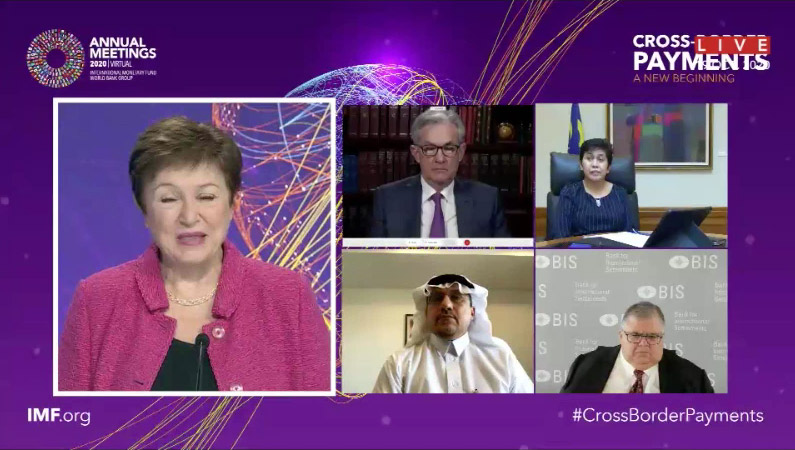Today the IMF held a series of panels on cross border payments, with the first one focusing on central bank digital currency (CBDC). The line up was an impressive one moderated by the IMF Managing Director, with the heads of the central banks of the U.S., Saudi Arabia (current G20 leader), and emerging market Malaysia as well as the General Manager of the Bank for International Settlements (BIS).
The basics are well covered in many central bank reports. We’ll focus on the highlights, with one of the most interesting points coming from the BIS on addressing emerging market risks.
Kristalina Georgieva, Managing Director of the International Monetary Fund (IMF), opened by highlighting that cross border payments are slow, opaque and costly. And they’re inaccessible to the 1.7 billion unbanked.
One of the IMF’s key roles is to foster international cooperation to enable the future of payments. The recent CBDC report from seven central banks and the BIS highlighted the IMF and World Bank involvement in cross border payments.
U.S. – getting it right more important than being first
Jerome Powell, Chair of the U.S. Federal Reserve reiterated that the Fed is committed to evaluating the costs and benefits of a CBDC, but there’s a lot of work to do first, including extensive public consultations. He outlined some of the CBDC research the U.S has started, but no decision has been made to proceed with a digital currency.
The Fed’s interest in CBDC is primarily for its payment system benefits. These advantages include faster, cheaper transactions, addressing the declining use of cash, and modernizing the payment infrastructure. But also to reach those traditionally “underserved by financial institutions”. However, he highlighted how many of these are not really issues in the U.S. with the FedNow payment system under development.
Talking about CBDC, he said, “I do think this is one of those issues where it’s more important for the United States to get it right than it is to be first. Given the dollar’s role globally, it’s essential that we remain on the frontier of research and policy development.”
It’s estimated that half of U.S. dollar notes, $1 trillion, is held outside of the United States.
According to Powell, the dollar’s strength comes from “the reliable rule of law, strong and transparent institutions, deep financial markets and an open capital account.” And he believes these reach far beyond technology.
Powell pointed out some of the tricky operational issues around a CBDC, such as the need to protect it from cyberattacks, counterfeiting and fraud. There’s also the potential for monetary policy impact and the trade-off of preventing illicit activity but still preserving consumer privacy.
There was an emphasis on the creation of public goods, but engaging the private sector for technology innovation. He explained why. “With payment systems there are going to be potentially large network effects which create increasing returns to scale, meaning we may well see over time the emergence of a small number of dominant players and ultimately great difficulty in competing with those players,” said Powell.
Emerging market threats
Moving on to Malaysia, Nor Shamsiah Mohd Yunus, Governor of the Central Bank outlined the risks of emerging market citizens adopting a global stablecoin or another country’s CBDC. However, issuing a local CBDC may not be the answer.
For example, if the reason for adopting an alternative currency is a lack of confidence in the local currency, then a digital version won’t help. If the problem is underdeveloped payment systems, there may be easier ways to address that with conventional systems. And in terms of global stablecoins and foreign CBDC risks, issuing a local CBDC isn’t likely to be the solution. Instead, it needs international collaboration.
Agustín Carstens, BIS General Manager, outlined how these sort of risks can be managed and the answer is a modern version of currency controls. If a local citizen wants to use a foreign CBDC from another country, the local central bank needs to provide approval. His point was that today we don’t know who is using $100 bills, but CBDC provides the technology to control who uses a government issued digital currency.
While Carstens seemed very bullish on CBDC and believes certain risks can be managed, he nonetheless emphasized the need to go slow to avoid mistakes. Because so many things could go wrong and there’s no room for error.
Digital identity
Meanwhile, Ahmed Alkholifey, Governor of the Saudi Arabian Monetary Authority, highlighted the importance of a reliable identity system that’s needed for know our customer (KYC). He acknowledged the potentially high costs of developing a national digital identity and digital KYC. But that’s especially important for cross border customer due diligence. And this is a building block towards efficient digital cross border payments.
When one considers the massive issue of national identity systems as just one building block, it’s another reason why it’s going to take time for CBDCs to proliferate. And the countries with existing digital identity systems have an advantage.






